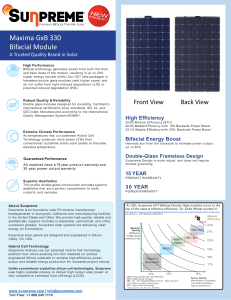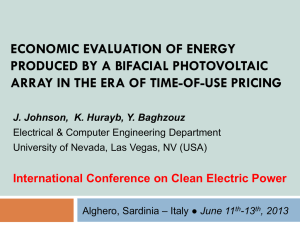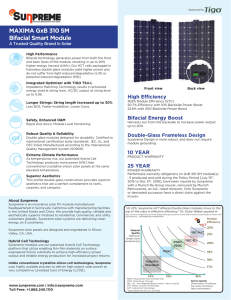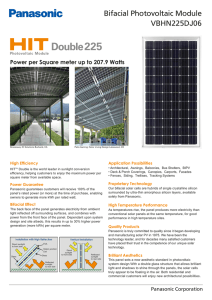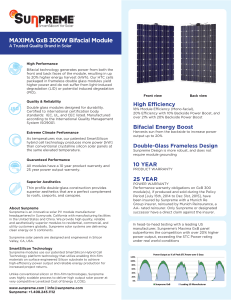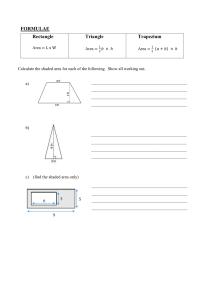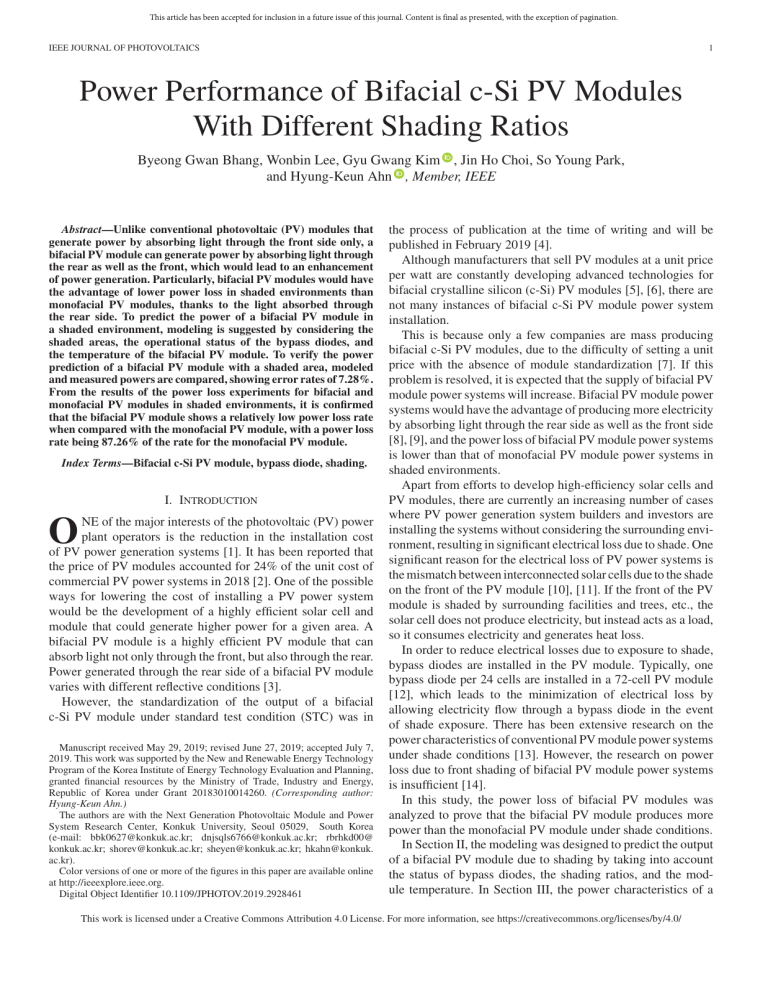
This article has been accepted for inclusion in a future issue of this journal. Content is final as presented, with the exception of pagination. IEEE JOURNAL OF PHOTOVOLTAICS 1 Power Performance of Bifacial c-Si PV Modules With Different Shading Ratios Byeong Gwan Bhang, Wonbin Lee, Gyu Gwang Kim , Jin Ho Choi, So Young Park, and Hyung-Keun Ahn , Member, IEEE Abstract—Unlike conventional photovoltaic (PV) modules that generate power by absorbing light through the front side only, a bifacial PV module can generate power by absorbing light through the rear as well as the front, which would lead to an enhancement of power generation. Particularly, bifacial PV modules would have the advantage of lower power loss in shaded environments than monofacial PV modules, thanks to the light absorbed through the rear side. To predict the power of a bifacial PV module in a shaded environment, modeling is suggested by considering the shaded areas, the operational status of the bypass diodes, and the temperature of the bifacial PV module. To verify the power prediction of a bifacial PV module with a shaded area, modeled and measured powers are compared, showing error rates of 7.28%. From the results of the power loss experiments for bifacial and monofacial PV modules in shaded environments, it is confirmed that the bifacial PV module shows a relatively low power loss rate when compared with the monofacial PV module, with a power loss rate being 87.26% of the rate for the monofacial PV module. Index Terms—Bifacial c-Si PV module, bypass diode, shading. I. INTRODUCTION NE of the major interests of the photovoltaic (PV) power plant operators is the reduction in the installation cost of PV power generation systems [1]. It has been reported that the price of PV modules accounted for 24% of the unit cost of commercial PV power systems in 2018 [2]. One of the possible ways for lowering the cost of installing a PV power system would be the development of a highly efficient solar cell and module that could generate higher power for a given area. A bifacial PV module is a highly efficient PV module that can absorb light not only through the front, but also through the rear. Power generated through the rear side of a bifacial PV module varies with different reflective conditions [3]. However, the standardization of the output of a bifacial c-Si PV module under standard test condition (STC) was in O Manuscript received May 29, 2019; revised June 27, 2019; accepted July 7, 2019. This work was supported by the New and Renewable Energy Technology Program of the Korea Institute of Energy Technology Evaluation and Planning, granted financial resources by the Ministry of Trade, Industry and Energy, Republic of Korea under Grant 20183010014260. (Corresponding author: Hyung-Keun Ahn.) The authors are with the Next Generation Photovoltaic Module and Power System Research Center, Konkuk University, Seoul 05029, South Korea (e-mail: bbk0627@konkuk.ac.kr; dnjsqls6766@konkuk.ac.kr; rbrhkd00@ konkuk.ac.kr; shorev@konkuk.ac.kr; sheyen@konkuk.ac.kr; hkahn@konkuk. ac.kr). Color versions of one or more of the figures in this paper are available online at http://ieeexplore.ieee.org. Digital Object Identifier 10.1109/JPHOTOV.2019.2928461 the process of publication at the time of writing and will be published in February 2019 [4]. Although manufacturers that sell PV modules at a unit price per watt are constantly developing advanced technologies for bifacial crystalline silicon (c-Si) PV modules [5], [6], there are not many instances of bifacial c-Si PV module power system installation. This is because only a few companies are mass producing bifacial c-Si PV modules, due to the difficulty of setting a unit price with the absence of module standardization [7]. If this problem is resolved, it is expected that the supply of bifacial PV module power systems will increase. Bifacial PV module power systems would have the advantage of producing more electricity by absorbing light through the rear side as well as the front side [8], [9], and the power loss of bifacial PV module power systems is lower than that of monofacial PV module power systems in shaded environments. Apart from efforts to develop high-efficiency solar cells and PV modules, there are currently an increasing number of cases where PV power generation system builders and investors are installing the systems without considering the surrounding environment, resulting in significant electrical loss due to shade. One significant reason for the electrical loss of PV power systems is the mismatch between interconnected solar cells due to the shade on the front of the PV module [10], [11]. If the front of the PV module is shaded by surrounding facilities and trees, etc., the solar cell does not produce electricity, but instead acts as a load, so it consumes electricity and generates heat loss. In order to reduce electrical losses due to exposure to shade, bypass diodes are installed in the PV module. Typically, one bypass diode per 24 cells are installed in a 72-cell PV module [12], which leads to the minimization of electrical loss by allowing electricity flow through a bypass diode in the event of shade exposure. There has been extensive research on the power characteristics of conventional PV module power systems under shade conditions [13]. However, the research on power loss due to front shading of bifacial PV module power systems is insufficient [14]. In this study, the power loss of bifacial PV modules was analyzed to prove that the bifacial PV module produces more power than the monofacial PV module under shade conditions. In Section II, the modeling was designed to predict the output of a bifacial PV module due to shading by taking into account the status of bypass diodes, the shading ratios, and the module temperature. In Section III, the power characteristics of a This work is licensed under a Creative Commons Attribution 4.0 License. For more information, see https://creativecommons.org/licenses/by/4.0/ This article has been accepted for inclusion in a future issue of this journal. Content is final as presented, with the exception of pagination. 2 IEEE JOURNAL OF PHOTOVOLTAICS Pmpp,r : maximum power of the rear under STC), which can be calculated by the following equations: BifiIsc = BifiPmpp = Isc,r ISC,f (3) Pmpp,r . Pmpp,f (4) Therefore, by considering bifaciality related to current, the MPP current generated by absorbed light from the rear can be expressed as shown in the following equation: Ir = BifiIsc · Fig. 1. Equivalent circuit for a bifacial solar cell. bifacial PV module were compared with those of a monofacial PV module under shaded conditions in outdoor experiments. Section IV discusses the contribution, limitations, and future research directions of this paper as a conclusion. II. MODELING A. Current and Voltage for Bifacial Solar Cells In order to predict the output of a bifacial PV module with shading ratios, the current and voltage of the bifacial solar cells that comprise a bifacial PV module were modeled. The maximum power point (MPP) current of a bifacial solar cell can be represented by the sum of the current (If ) generated by the absorbed light from the front, and the current (Ir ) generated by the absorbed light from the rear [15], as shown in Fig. 1 with the following equation: Icell = If + Ir . (1) Because the current of a solar cell tends to be proportional to the irradiation [16], the relation between the front irradiation of a bifacial solar cell (Sf ) and the current generated (Impp, f ) from light through the front under STC (1000 W/m2 , 25 °C, AM 1.5) can be represented as shown in the following equation: If = Sf · Impp,f . 1000 W/m2 (2) The expression of the current produced by the absorbed light from the rear side could be calculated similarly to (2), but the power difference between the front and the rear under the same irradiation condition must be taken into account. The electrical characteristics of the front and the rear of a bifacial solar cell differ according to the impurity doping concentration, passivation layer, and distance from the depletion layer, with the result that the efficiency of the front of a bifacial solar cell is higher than that of the rear [17]. Bifaciality (Bifi) is one of the ways to differentiate between the front and rear. Bifaciality can be expressed in terms of equations with respect to short-circuit currents (ISC,f : short-circuit current of the front under STC; ISC,r : short circuit current of the rear under STC) and maximum powers (Pmpp,f : maximum power of the front under STC; Sr · Impp,f . 1000 W/m2 (5) In addition, in order to predict the current of a bifacial solar cell with shading ratios, the shaded area and the temperature coefficient should be taken into account. When the shaded front area of a bifacial solar cell is referred to as SDf , the shaded rear area is referred to as SDr , and the temperature coefficient of the short current (Isc ) is referred to as δIsc . Considering these factors, the current for a bifacial solar cell can be expressed as shown in the following equation: Sf SRf · Impp,f · 1 − Icell = 1000 W/m2 100 Sr SRr + BifiIsc · · I · 1 − mpp,f 1000 W/m2 100 ◦ δI (t − 25 C) · 1 + sc (6) 100 SD r · 100%. where SRf = Acellf · 100%, SRr = ASD cell On the other hand, when a solar cell generates electricity, the current increases as the irradiation increases, but the voltage is almost constant [18]. Therefore, the irradiation and the shaded area are assumed to have little effect on the voltage of a bifacial solar cell, unlike current, and only the temperature coefficient is taken into account. That is, when the temperature coefficient of open voltage (Voc ) is δVoc , and the voltage under STC is Vmpp , the voltage of a solar cell is expressed as shown in the following equation: δVOC (t − 25 ◦ C) Vcell = Vmpp · 1 + . (7) 100 B. Current and Voltage for a Bifacial PV Module Based on the voltage and current of the bifacial solar cells that compose a bifacial PV module as predicted in Section II-A, the voltage and current of a bifacial PV module can be predicted. Fig. 2 shows the equivalent circuit of a bifacial PV module with a total of m · n solar cells connected in series by connecting m solar cells per one bypass diode. Because the current of series-connected solar cells is approximately the same as the lowest current [19], when the current of the yth solar cell among series-connected solar cells with an xth bypass diode is denoted as Icellx_y , the current flowing between the (+) and (−) terminals is referred to as IS1 (current flowing through series-connected solar cells without flowing This article has been accepted for inclusion in a future issue of this journal. Content is final as presented, with the exception of pagination. BHANG et al.: POWER PERFORMANCE OF BIFACIAL c-Si PV MODULES WITH DIFFERENT SHADING RATIOS 3 TABLE I SPECIFICATIONS FOR A BIFACIAL SOLAR CELL Fig. 2. a series-connected structure as shown in Fig. 2, the voltage of a bifacial PV module is expressed as the sum of the voltages of each structure. Then, the voltage is calculated as shown in the following equation: Equivalent circuit for a bifacial PV module. into a bypass diode(D1 ). IS1 can be expressed as shown in the following equation: min (Icell,1_1 , Icell,1_2 , . . . , Icell,1_m ) SR < k IS1 = 0 SR ≥ k. (8) Equation (8) postulates that if the shading ratio in the seriesconnected solar cells is less than k, the minimum value of the current among m solar cells would be IS1 . However, if the shaded area ratio is larger than k, the current would flow through the bypass diode, meaning that the current would not flow toward the solar cells at all (it is assumed that there is no leakage current). Meanwhile, the voltage between the (+) and (−) terminals is shown in the following equation: m · Vcell SR < k (9) VS1 = −VD1 SR ≥ k. If the shaded area ratio of solar cells connected by a bypass diode is less than k (operation point of a bypass diode), the total voltage of the series-connected solar cells is equal to the sum of each solar cell. That is, if all solar cells are the same, the total voltage would be the same as m · Vcell (= Vcell + Vcell + · · · + Vcell ). However, if the shaded area ratio is larger than k, in which case the voltage between the (+) and (−) terminals would indicate reverse bias, VS1 would be −VD1 . In this way, the currents and voltages between the (+) and (−) terminals of series-connected solar cells, and each bypass diode (D2 , D3 , and so on), can be obtained. Bifacial PV modules in a series of n structures are illustrated in Fig. 2. Therefore, the current of a bifacial PV module can be calculated as shown in the following equation: Imodule = min (IS1 , IS2 , . . . , ISn ) (10) where IS1 · IS2 , . . . , ISn = 0. However, there is a difference between (9) and (10). In (10), when Imodule is calculated, the minimum value must be obtained, except for IS with a value of 0. This is because Imodule is a current that flows through both the series-connected solar cells and the bypass diodes, and not through the solar cells only. Likewise, if it is assumed that bifacial PV modules are Vmodule = VS1 + VS2 + · · · + VSn . (11) Finally, the power of a bifacial PV module at MPP can be presented as shown in (12), as a product of the voltage and current Pmodule = Imodule · Vmodule . (12) III. EXPERIMENTS AND RESULTS A. Experiments for a Bifacial Solar Cell Experiments on the power performance of bifacial PV modules according to various shading ratios were conducted to prove that the current of a solar cell decreases in relation to the shaded area, as mentioned in Section II. The specifications of the bifacial solar cell used in the experiments are described in Table I. From the perspective of experiments for a bifacial solar cell, it is expected that the performance characteristics of a bifacial PV module that is composed of one cell and all the elements of PV module are similar to those of a 72-cell bifacial PV module rather than the one bifacial solar cell itself. Therefore, one bifacial solar cell was modularized in order to conduct the experiments. The lamination process was carried out by layering with lowiron tempered glass, EVA (ethylene-vinyl acetate copolymer), a bifacial solar cell, EVA, followed by a clear back sheet. The STC power of the manufactured 1 × 1 bifacial PV module was 4.22 W. Cell-to-module (CTM) loss was relatively large, which is believed to have increased CTM loss due to the relatively greater proportion of ribbon resistance and contact resistance. Using the 1 × 1 bifacial PV module, the experiments for power loss due to the ratio of the shaded area were conducted as shown in Fig. 3. Fig. 4 shows the current–voltage [(I) − (v)] and maximum power–voltage [(p) − (v)] characteristic curves for a 1 × 1 bifacial PV module under different shade conditions. As shown in Fig. 4, it can be seen that as the shaded area increases, the current decreases linearly and voltage decreases just slightly, resulting in a linear decrease in the maximum power as well. In order to show the trend clearly, normalized values based on a shaded area of 0% for a 1 × 1 bifacial PV module are shown in Table II. As shown in Table II, it can be seen that the current of a bifacial PV module as well as the conventional PV module is reduced This article has been accepted for inclusion in a future issue of this journal. Content is final as presented, with the exception of pagination. 4 Fig. 3. IEEE JOURNAL OF PHOTOVOLTAICS Experimental conditions for change in the ratio of the shaded area. Fig. 5. Variation in current and voltage for a bifacial PV module by temperature. TABLE III SPECIFICATIONS OF PV MODULES UNDER STC Fig. 4. I–V and P –V characteristic curves for a 1 × 1 bifacial PV module due to change in shading ratios in a bifacial solar cell. TABLE II NORMALIZED VALUES FOR A 1 × 1 BIFACIAL PV MODULE over the range 25 − 55 ◦ C, when the irradiation of the bifacial PV module was 1000 W/m2 . Fig. 5 shows the current and voltage values by temperature of the front and rear of the bifacial PV module. Fig. 5 shows that the currents of the bifacial PV module increase as the temperature increases, but the rate of increase of 0.03%/C is so small that it is within the range of error. However, the voltage of both the front and the rear of the bifacial PV module decreases linearly as the temperature increases, with a reduction rate of approximately 0.31%/C. Because PV modules generate electricity, resulting in an increase of module temperature [20], it is imperative to consider the temperature coefficient when predicting the power of PV modules. B. Experiments for a Bifacial PV Module in proportion to the shaded area ratio. The average error rate of the maximum power current with linearized values is 1.22%, and the maximum error rate is 3.16%. Therefore, it is possible to model the decrease in current relative to the shaded area, as shown in (6). Temperature is one of the main factors that greatly affects the power of the PV module. However, the standard for measuring the temperature coefficient for bifacial PV modules is still being prepared. For this reason, the temperature coefficient was measured in the same way as a conventional PV module for this study. The temperature coefficients for the front and the rear of a bifacial PV module were measured, with a black plate covering the back. Measurements were taken at 5 °C intervals In order to compare the power performance of a bifacial PV module and a monofacial PV module relative to the shading ratio, both PV modules were manufactured with 72 seriesconnected bifacial solar cells. One bypass diode was installed per 24 solar cells, and a total of three bypass diodes were installed in a PV module. The bifacial PV module had a transparent back sheet, and the monofacial PV module had a white back sheet. The specifications for the PV modules used in the experiments are shown in Table III. Although the bifacial PV module and the monofacial PV module were both manufactured using identical bifacial solar cells, there was a difference of 5 W in the front-side power. This is due to the higher reflection of the white back sheet, which has a higher reflectivity than the transparent back sheet, This article has been accepted for inclusion in a future issue of this journal. Content is final as presented, with the exception of pagination. BHANG et al.: POWER PERFORMANCE OF BIFACIAL c-Si PV MODULES WITH DIFFERENT SHADING RATIOS Fig. 6. I–V characteristic curves for the bifacial and monofacial PV modules with shaded area in one solar cell. on the back of the monofacial PV module, resulting in higher current [21]. The outdoor experiments were conducted on the roof of University Engineering College in Seoul, South Korea (37◦ 54 11 N , 127◦ 07 97 E). The floor of the roof was made of concrete, with an albedo of 0.16, and the PV modules were installed on a stand at an angle of 30◦ from the floor, and a height of 0.1 m from the ground to the bottom of the frame. The power measurement equipment used in the experiments was Profitest from Gossen, and the measurable limits were: a voltage of 1000 V, current of 20 A, and a maximum power of 20 kW. During the experiments, measurements were collected for open-circuit voltage, short-circuit current, voltage of maximum power point, current of maximum power point, maximum power, module temperature, and irradiation of front and rear surface. Shaded environments were created using thick black paper that did not transmit light. Fig. 6 shows the I–V curve of the bifacial PV module and the monofacial PV module according to the ratio of the shaded area of one solar cell (0, 20, 40, 50, 60, 80, 100%) in areas with an irradiation of 900 ± 20 W/m2 . As shown in Fig. 6, the bifacial PV module has a larger short-circuit current than the monofacial PV module due to the presence of a current generated by the light coming into the rear. In addition, it can be seen that the bypass diode began to operate when the shaded area of a solar cell was 20%–50%. The currents rapidly decrease as the bypass diodes start to operate at 25–30 V in the I–V characteristic curves for both the bifacial PV module and the monofacial PV modules. However, because generated current from the rear of the bifacial PV module also flows, it can be seen that the width of decrease in the current for the bifacial PV modules was relatively smaller at voltages in the range of more than or equal to 25–30 V compared with that of the monofacial PV module. Fig. 7 shows the I–V characteristic 5 Fig. 7. I–V characteristic curves for the bifacial and monofacial PV modules with shaded area in solar cells connected to one bypass diode. curves of the bifacial PV module and the monofacial PV module when 24 solar cells that were series-connected to one bypass diode were shaded. At voltages above 30 V, because the monofacial module generates electricity only from light through the front surface, there is little current flowing, as shown in Fig. 7. However, for the bifacial PV module, there is current generated by the light coming into the rear surface, resulting in relatively more current flow than the monofacial PV module. The voltages at the maximum power points, however, are lower than the voltage at the point at which the graph curves sharply, and the shaded areas are not directly related to maximum power under the condition that the solar cells connected to one bypass diode were shaded. In addition, the maximum power voltages for the PV modules are almost the same, and it can be seen that there is a difference in the maximum power due to the current. Fig. 8 shows the I–V characteristic curves of the bifacial PV module and the monofacial PV module according to the number of bypass diodes in operation due to the shaded areas of 0 to 72 solar cells. As shown in Fig. 8, with the 24 solar cells shaded (when one bypass diode operates) and 48 solar cells shaded (when two bypass diodes operate), it can be seen that the voltage is approximately 2/3 and 1/3 that of the voltage without shading, respectively. Thus, the maximum powers are approximately 2/3 and 1/3 that of the power without shading, respectively. However, when all 72 solar cells on the front surface are shaded, there is little current when the monofacial PV module generates electricity from light coming in through the front only, resulting in little power. However, it was confirmed that a little current flowed from the light coming in through the rear of the bifacial PV module, which led to relatively high power. This article has been accepted for inclusion in a future issue of this journal. Content is final as presented, with the exception of pagination. 6 IEEE JOURNAL OF PHOTOVOLTAICS TABLE IV COMPARISONS OF POWER LOSS FOR BIFACIAL AND MONOFACIAL PV MODULES IN SHADED ENVIRONMENTS Fig. 8. I–V characteristic curves for the bifacial and monofacial PV modules with shaded area in solar cells connected to several bypass diodes. Fig. 10. Comparisons of power loss for bifacial and monofacial PV modules in shaded environments. Fig. 9. Comparison of modeled and actual values for the bifacial PV module with shading ratios. C. Model Verification Fig. 9 shows the predicted and actual values for the changes in the shaded area of the bifacial PV module with an irradiation of 900 ± 20 W/m2 under the partially shaded condition due to the holder separated approximately 5 cm from the rear surface of the module to verify the prediction model in Section II. The predicted and actual power of the bifacial PV module with shading ratios showed an error rate of 7.28% on average. The reason the error rate was relatively large is because the predicted error rates were 8.6% (when 20% of the area of a solar cell was shaded), and 42.89% when the bypass diode started to operate (and when 50% of the area of a solar cell was shaded). In addition, the reason why the error rate is relatively higher when 72 solar cells are shaded is because the effects of the structures and frames that could affect irradiation of the rear panel were relatively large. For the other areas, the average error rate was 4.09%, which was relatively low. D. Comparison of Shading Effects for the Bifacial PV Module and Monofacial PV Module In order to compare the effects of shading for the bifacial module and monofacial PV module, the power percentages of PV modules in shaded environments were compared for the same shaded area, as shown in Table IV and Fig. 10. Prior to the comparisons, the proportions of the relative power loss in the bifacial PV module compared with that of the monofacial PV module were calculated as shown in the following equation: RD = 100 − RPbifacial × 100% 100 − RPmonofacial where RPbifacial = RPmonofacial = Pbifacial, shading · 100% Pbifacial,no_shading Pmonofacial, shading · 100%. Pmonofacial,no_shading (13) As shown in Table IV and Fig. 10, when the shaded areas in monofacial and bifacial PV modules are identical, the ratio of This article has been accepted for inclusion in a future issue of this journal. Content is final as presented, with the exception of pagination. BHANG et al.: POWER PERFORMANCE OF BIFACIAL c-Si PV MODULES WITH DIFFERENT SHADING RATIOS 7 shadow to the PV modules. In addition, as the sun went down, the power ratios grew. From these results, it can be seen that bifacial modules are more efficient than monofacial PV modules not only in shaded environments, but also under low irradiation. IV. CONCLUSION Fig. 11. time. Bifacial and monofacial PV modules shaded by the building over Fig. 12. Comparisons of power for bifacial and monofacial module in shade conditions due to having a building in front of them. power loss for the bifacial PV modules are lower than that of the monofacial PV module. In the event of identical shaded areas, the ratio of the bifacial PV module power loss to the monofacial PV module was 87.26% on average. In other words, results confirmed that the bifacial PV module is more efficient than the monofacial PV module under identical shade environments. In order to compare the power performance of the bifacial and the monofacial PV modules in shade due to having a building in front of them, as shown in Fig. 11, the power and the ratios of the power for the bifacial PV module to the power for the monofacial PV module are shown in Fig. 12. The PV modules used in outdoor experiments have been installed on the rooftop of the four-story building. In front of the building, there is a tall building which is a 12-story high. The sun moves from east to west, resulting in the shade on the PV modules due to the front building. Fig. 12 shows the ratios of power for the bifacial PV module to power for the monofacial PV module in shade conditions due to the surrounding building from 12:45 P.M. to 3:15 P.M. Before shading, the ratio of power for the bifacial and monofacial PV module was 1.02 on average. However, the power ratios rose from 1.13 to 1.34 except for the abnormal values (such as the condition where the monofacial PV module is shaded and the bifacial PV module is not shaded) as soon as the building cast a In this paper, studies to demonstrate the benefits of bifacial PV modules in a shaded environment were conducted by analyzing the power characteristics of the bifacial PV module compared with the conventional PV module under shade conditions. In order to analyze the power characteristics of the bifacial PV module in a shaded environment, the power prediction for the bifacial PV module was modeled considering the operation of the bypass diodes, the shaded area in the PV module, and the PV module temperature. From the results of the simulations and experiments, the model showed an average error rate of 7.28%. However, without transient condition under the operation of bypass diode, an average error rate of model is 4.09%, showing relatively reduced error rate. In addition, the power loss ratios of the bifacial PV module to the monofacial PV module were compared under identical shade conditions. From the results of the outdoor experiments, the ratio of power loss for the bifacial PV module to that of the monofacial PV module was 87.26%–100%, confirming that the bifacial PV module is more efficient than the monofacial PV module under identical shade condition. It is anticipated that this study may contribute to efficient operation and maintenance by determining whether the bifacial PV module is shaded or not, and whether it is abnormal. Furthermore, this study would contribute to securing the long-term reliability of PV generation systems implemented with bifacial PV modules, such as floating and marine PVs with high albedo, when bifacial PV module generation systems become more common. However, in this study, the irradiation of the rear panel was measured only at one point, showing a relatively high error rate. In order to predict the power performance for the bifacial PV module, further research on the uniformity of rear irradiation with different installation height, angle, and albedo should be carried out. REFERENCES [1] A. Goodrich, T. James, and M. Woodhouse, “Residential, commercial, utility-scale photovoltaic (PV) system prices in the United States: Current drivers and cost-reduction opportunities,” Nat. Renewable Energy Lab., Golden, CO, USA, Rep. NREL/TP-6A20-53347, 2012. [2] R. Fu, R. M. Margolis, and D. J. Feldman, “US solar photovoltaic system cost benchmark: Q1 2018,” Nat. Renewable Energy Lab., Golden, CO, USA, NREL/TP-6A20-72399, 2018. [3] G. J. M. Janssen, B. B. Van Aken, A. J. Carr, and A. A. Mewe, “Outdoor performance of bifacial modules by measurements and modelling,” Energy Procedia, vol. 77, pp. 364–373, 2015. [4] J. Stein, “Final project report: Performance models and standards for bifacial PV module technologies,” Sandia National Lab., Albuquerque, NM, USA, SAND2018-12028R, 2018. [5] X. Yan et al., “Investigation of phosphorus diffused back surface field (BSF) in bifacial nFAB solar cells,” Sol. Energy, vol. 179, pp. 335–342, 2019. This article has been accepted for inclusion in a future issue of this journal. Content is final as presented, with the exception of pagination. 8 IEEE JOURNAL OF PHOTOVOLTAICS [6] V. Shanmugam et al., “Impact of the manufacturing process on the reversebias characteristics of high-efficiency n-type bifacial silicon wafer solar cells,” Sol. Energy Mater. Sol. Cells, vol. 191, pp. 117–122, 2019. [7] H. Nussbaumer et al., “Energy yield prediction of a bifacial PV system with a miniaturized test array,” Sol. Energy, vol. 179, pp. 316–325, 2019. [8] A. Asgharzadeh et al., “A sensitivity study of the impact of installation parameters and system configuration on the performance of bifacial PV arrays,” IEEE J. Photovolt., vol. 8, no. 3, pp. 798–805, May 2018. [9] E. Molin et al., “Experimental yield study of bifacial PV modules in nordic conditions,” IEEE J. Photovolt., vol. 8, no. 6, pp. 1457–1463, Nov. 2018. [10] M. Gokdag et al., “Switched-capacitor converter for PV modules under partial shading and mismatch conditions,” Sol. Energy, vol. 170, pp. 723–731, Aug. 2018. [11] A. Mohapatra et al., “A review on MPPT techniques of PV system under partial shading condition,” Renewable Sustain. Energy Rev., vol. 80, pp. 854–867, 2017. [12] A. Peled and J. Appelbaum, “The view-factor effect shaping of I-V characteristics,” Prog. Photovolt., Res. Appl., vol. 26, no. 4, pp. 273–280, Apr. 2018. [13] S. Gallardo-Saavedra and B. Karlsson. “Simulation, validation and analysis of shading effects on a PV system,” Sol. Energy, vol. 170, pp. 828–839, Aug. 2018. [14] J. Bai et al., “Characteristic output of PV systems under partial shading or mismatch conditions,” Sol. Energy, vol. 112, pp. 41–54, 2015. [15] U. Yusufoglu and A. Halm, “Modeling and simulation of annual energy yields of bifacial modules at different climate zones,” in Proc. 2nd bifiPV Workshop, Chambery, France, May 2014. [16] H. Cha et al., “Power prediction of bifacial Si PV module with different reflection conditions on rooftop,” Appl. Sci., vol. 8, no. 10, Oct. 2018, Art. no. 1752. [17] G. J. M. Janssen et al., “Aspects of bifacial cell efficiency,” Energy Procedia, vol. 124, pp. 76–83, Sep. 2017. [18] E. E. Van Dyk et al., “Monitoring current–voltage characteristics and energy output of silicon photovoltaic modules," Renewable Energy, vol. 30, no. 3, pp. 399–411, Mar. 2005. [19] J. L. Crozier et al., “Identification and characterization of performance limiting defects and cell mismatch in photovoltaic modules,” J. Energy Southern Africa, vol. 26, no. 3, pp. 19–26, Aug. 2015. [20] A. H. Al-Badi, “Measured performance evaluation of a 1.4 kW grid connected desert type PV in Oman,” Energy Sustain. Develop., vol. 47, pp. 107–113, Dec. 2018. [21] B. B. Van Aken, “White bifacial modules–improved STC performance combined with bifacial energy yield,” in Proc. 32nd Eur. Photovolt. Sol. Energy Conf., Munchen, Germany, Jun. 2016. Byeong Gwan Bhang received the B.S. and M.S. degrees in electrical engineering from Konkuk University, Seoul, South Korea, in 2017 and 2019. He is currently working toward the Ph.D. degree at Next Generation Photovoltaic Module and Power System Research Center, Konkuk University. His research interests include utility of floating photovoltaics and marine photovoltaics and their operations and maintenance using big data analysis. Wonbin Lee received the B.S. degree in electrical engineering from Konkuk University, Seoul, South Korea, in 2019. He is currently working toward the master’s degree at Next Generation Photovoltaic Module and Power System Research Center, Konkuk University. His research interests include utility of floating photovoltaics and marine photovoltaics. Gyu Gwang Kim received the B.S. and M.S. degrees in electrical engineering from Konkuk University, Seoul, South Korea, in 2016 and 2019, respectively. Currently, he is working with Chungbuk Techno Park, Chungbuk, South Korea. His research interests include the predictive models for photovoltaic module performance and power system evaluation for marine photovoltaics and microgrid networks. Jin Ho Choi received the B.S and M.S. degrees in electrical engineering from Konkuk University, Seoul, South Korea, in 2018 and 2019, respectively. He is currently working toward the Ph.D. degree in electrical engineering in Konkuk University. His research interests include power performance of bifacial photovoltaics module for floating and marine photovoltaics. So Young Park received the B.S. and M.S. degrees in electrical engineering from Konkuk University, Seoul, South Korea, in 2018 and 2019, respectively. She is currently working with New and Renewable Energy Nanum Corporation, Yongin, South Korea. Her research interests include the issue of performance evaluation of marine photovoltaics and building integrated photovoltaics. Hyung-Keun Ahn (M’92) received the B.S. and M.S. degrees in MOSFETs in electrical engineering from Yonsei University, Seoul, South Korea, in 1983 and 1985, respectively, and the Ph.D. degree in HEMTs from the University of Pittsburgh, Pittsburgh, PA, USA, in 1993. From 1986 to 1995, he was with the LG Semiconductor Co., working on silicon-based device design and process integration. In 1995, he joined the Department of Electrical Engineering, Konkuk University, Seoul, where he is a Professor and the Dean of Next Generation PV Module and Power System R&D Center. From 2014 to 2016, he was also a Foreign Professor with the Department of Electrical and Control Engineering, Division of EE, Shandong University of Technology, Zibo, China. His research interests include reliability of both Si and GaAs-based solar cells and photovoltaics (PV) modules for applications in micro roof-top to large scale of PVs connected with ESS, focusing on failure analysis, reliability, and MRO (maintenance, repair, and operation). He was the first National Photovoltaic Research and Development Program Director of the Ministry of Knowledge Economy, South Korea, from 2009 to 2011. He is currently working on design of microgrid network for net-zero energy house and city using ESS, bifacial and shingled PVs, applicable to floating and marine PVs under the demand response control. Dr. Ahn was a Committee Member of the National Science and Technology Commission, Energy Department, from 2005 to 2007.
